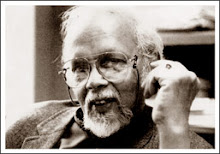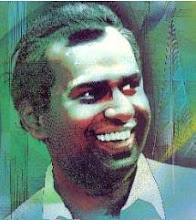Source: Sunday Observer
Date: 18/03/2007
We have already described two traditional dramas in Sri Lanka in previous articles. Today, we feature the last of this series, 'Nadagam'.
Due to cultural relations and the tradition of getting queens for the kings of the Kandyan era from India, we received this wonderful traditional drama from India. In South India, this type of drama was popular under the names of 'Baghavati-mela' and 'Thurukuththu' or street dramas.
These dramas are similar to Western operas and Peking musical dramas.The first nadagam drama to be staged in Sri Lanka was 'Harischandra', a drama which was very popular in South India at that time. Earlier nadagam dramas were mostly directed in Tamil; Peduru Silva, who was born in Modara, had translated 'Harischandra' into Sinhala in 1801. There had been many Sinhala nadagam dramas since then.
Sinhala in 1801. There had been many Sinhala nadagam dramas since then.
The father of Sinhala nadagam is known as Pilippusinno (born in 1770). He was popular as a composer too. He is credited with writing the first nadagam in Sinhala.
These nadagam have a touch of Christianity, because almost all nadagam writers were Christians. It had taken some time to relate Buddhist stories to nadagam.
Nadagam are very popular in the coastal areas. They were mostly seen in Jaffna, Chilaw, Colombo, Matara, Weligama and Tangalle. Though the idea was generated at Hanguranketha, it was put into action in Colombo.
Acting style
It had been a tradition in the olden days to perform nadagam for seven days. Then slowly, it had become limited to one night. Those who don't have the ability to sing cannot act in nadagam. When the Pothe Gura (narrator) finishes describing the story, Pathrya comes to the stage according to the drum beat.
After making his entry, he introduces himself to the audience, through a song. In earlier 'nadagam,' the female characters were acted by males, but nowadays, females also take part in these dramas. In ancient days, the news about an impending nadagam was told through 'Anabera.'
The style of walking in nadagam is just as important as the songs. So, a lot of attention is paid to this walk.  When the 'Pothe Gura' introduces a character with a song, those characters enter the stage according to a specific style which belongs to the character.
When the 'Pothe Gura' introduces a character with a song, those characters enter the stage according to a specific style which belongs to the character.
For this purpose, they have a traditional beat. The beats differ for each character. Simple music is used for nadagam. The music had evolved from Karnata music and had later taken a native face. Now these songs are mostly sung as traditional village songs.
Simple music is used for nadagam. The music had evolved from Karnata music and had later taken a native face. Now these songs are mostly sung as traditional village songs.
There are around 24 types of nadagam music. At first, these songs had a Tamil touch, but later, when they started to be sung by villagers, they gained a native flavour.
The place where a nadagam is staged is known as 'Karaliya.' Alongside that, a shelter is also built, to cover the Karaliya. Between the shelter and Karaliya, painted curtains will be hung.
Around 1855, nadagam was staged in house stages as well. The first nadagama which was staged in a house was 'Konchi.' Those are the usual parts seen in all nadagam. After the arrival of the king, the first part of the drama will be over and the second part will begin.
Characters1. Pothe guru:- He comes to the Karaliya, singing what is known as full (Poorna) song. This is done to invite the gods. He worships the Triple Gem and introduces the nadagama through this song.
2. Bahuboothaya:- The first one to come on stage, he is a comedian- type character.
3. Sellam Lama:- He comes on stage with a pen. He is shown as a handsome guy wearing valuable jewellery who has excelled in all fields.
4. Lecturers:- These two describe the nadagam.
5. Messenger:- They are known as drummers at the king's palace.
6. Handa Dhoothayo:- Their duty is to inform the public about the arrival of the king.
7. Asane Virinduva:- Pothe guru will sing this song when the king and the ministers arrive at the place. After this, they will take their seats.




































No comments:
Post a Comment